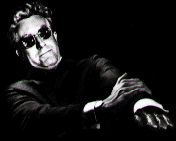 Study
Questions: Week Seven
Study
Questions: Week Seven Study
Questions: Week Seven
Study
Questions: Week Seven
Strange Loves in Peace and War
Lolita (1962) and Dr. Strangelove (1964)
Sex and death are never far apart in Kubrick's films (especially in Eyes Wide Shut), and the relationship is evident in both Lolita and Dr. Strangelove. Lolita marks Kubrick's departure from the familiar genre films which he had made during the 1950s. In adapting Vladimir Nabokov's novel, the director turned his satirical eye on both American culture and on the destructive obsessions which drive supposedly intelligent and sophisticated characters to murder. The same themes move from the personal and domestic in Lolita to the public and the political in Dr. Strangelove. The latter film was begun as a serious drama about the dangers of nuclear war in the manner of Stanley Kramer's On the Beach (1959) and Sidney Lumet's Fail Safe (1964), but soon Kubrick decided that the absurdity of the situation was best treated as a black comedy. Thus the nuclear standoff between the United States and the Soviet Union becomes an arena where chaotic and demonic inner lives of both countries' leaders end in a nuclear holocaust.
Lolita: When My Mother Finds Out
1. Why would Kubrick begin the film with scene in which Humbert shoots Quilty? How does the scene insure that the audience knows that Humbert's dream will not be fulfilled?
2. What does the decor of Quilty's house reveal about the man and his life?
3. How does the film present Lolita's mother. What does the decoration of her house and her intellectual interests tell us about her? To what degree does she represent the spirit of Ramsdale?
4. What is Humbert's attraction to Lolita? How does the film make this desire seem funny?
5. Why does Kubrick use Peter Sellers in three different roles? How do the multiple roles help to transform the character into Humbert's nemesis, the figure whose function is to embody the fears and anxieties that accompany Humbert's desires?
6. In what ways might the theme of a destructive sexuality be compared to similar themes in The Killing and Dr. Strangelove?
7. How do the names of places create the impression of a society that is both repressed and highly eroticized?
8. How does Kubrick use the high school dance to satirize American culture?
9. What does Charlotte Haze's attraction to Quilty say about her intellectual and cultural pretensions? What does it say about our culture's tendency to over value celebrity?
10. What is the importance of Quilty, in the guise of a police officer at the Enchanted Hunter, talking to Humbert? How does his speech manage to seem both innocent and accusing at the same time?
11. Why is the figure of the psychologist who visits Humbert so sinister? Why does he appear to materialize out of the darkness? In what way is he similar to the figure of Dr. Strangelove? How does Kubrick use him to satirize popular views of psychotherapy.
12. What does the final encounter between Humbert and Lolita reveal about the difference between his fantasies and reality?
13. What is your final judgment of Humbert? How is he to be compared to the other major adult characters?
Dr. Strangelove: And Don't Forget to Say Your Prayers
1. How does the opening image of the the bomber being refueled together with the song on the soundtrack foreshadow one of the film's central themes?
2. How does the three-part narrative structure (Burpleson Air Force Base, the B-52, and the War Room) serve to build dramatic tension? Why do the sequences in each of the narrative threads keep getting shorter?
3. How are each of the narrative threads given a distinctive visual style (consider the way the camera moves; the way scenes are composed; and the way the characters moce)?
4. Characters in satire are often presented as caricatures to make them the objects of laughter rather than sympathy. How does Kubrick achieve this effect in the case of Generals Ripper (Sterling Hayden) and Turgidson (George C. Scott), Col. Guano (Keenan Wynn), Major Kong (Slim Pickens), and Dr. Strangelove (Peter Sellers). How do their names contribute to the comedy?
5. In what way does each of the above characters express a bizarre taste for mixing the erotic and the deadly (or to use Freud's terms, eros and thanatos)?
6. What is the significance of the names written on the nuclear bombs: "Hi There" and "Dear John"? How do the names reflect the film's themes?
7. What is the significance of having the Russian Ambassador (Peter Bull) actually trying to photograph the War Room?
8. The references to flouridation of water, the mineshaft gap, and the Americanized ex-Nazi scientist (among others) are very topical and refer to very real events and people. Can you identify them? Does whether you do or not make affest your enjoyment of the film? Why? Why not?
9. In what ways does the behavior of the generals in the War Room suggest that of adolescents? Consider Turgidson's phone conversation with his secretary, the argument over whose forces are the best fighters, President Muffley's (Peter Sellers) phone conversation with the Soviet Premier, and Strangelove's description of life in the mineshaft dwellings after the Doomsday device has done its work.
10. The Strategic Air Command's motto in the film is "Peace Is Our Profession." Ths is not Kubrickian irony; it is the real motto. How does knowing this help explain why Kubrick changed his film from a serious drama to black comedy?